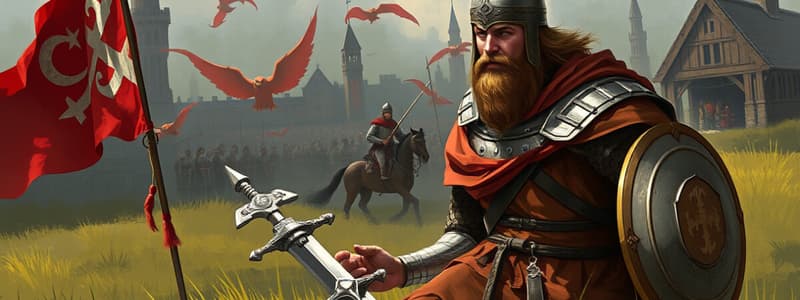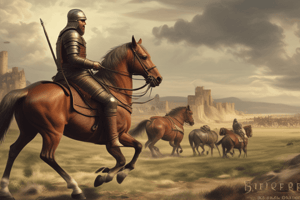Podcast
Questions and Answers
What event triggered William of Normandy's invasion of England?
What event triggered William of Normandy's invasion of England?
- The crowning of a rival king
- Dispute over land ownership
- Edward the Confessor's death without an heir (correct)
- Death of Harold Godwinson
What was the role of the Witan in the selection of the king?
What was the role of the Witan in the selection of the king?
- A council of commoners
- An assembly of clergy
- A group of military leaders
- A council of noblemen (correct)
What significant battle did William the Conqueror win to secure his control over England?
What significant battle did William the Conqueror win to secure his control over England?
- Battle of Austerlitz
- Battle of Agincourt
- Battle of Hastings (correct)
- Battle of Towton
What was the main purpose of the feudal system in the Middle Ages?
What was the main purpose of the feudal system in the Middle Ages?
Which of the following figures was known as 'Charles the Great'?
Which of the following figures was known as 'Charles the Great'?
What title was Charlemagne awarded by the Pope?
What title was Charlemagne awarded by the Pope?
What were fiefs in the feudal system?
What were fiefs in the feudal system?
What was a key characteristic of William the Conqueror's leadership style?
What was a key characteristic of William the Conqueror's leadership style?
What was the primary reason the colonists opposed the Townshend Acts?
What was the primary reason the colonists opposed the Townshend Acts?
What significant event happened on March 5, 1770?
What significant event happened on March 5, 1770?
Who is Crispus Attucks recognized as in American history?
Who is Crispus Attucks recognized as in American history?
What rallying cry did the Patriots use to unify colonists?
What rallying cry did the Patriots use to unify colonists?
What role did propaganda play in the colonial resistance against Britain?
What role did propaganda play in the colonial resistance against Britain?
What was a central feature of feudalism during the Middle Ages?
What was a central feature of feudalism during the Middle Ages?
Which type of castle was characterized by being almost invincible due to its structure?
Which type of castle was characterized by being almost invincible due to its structure?
What prompted the Pope to call for the Crusades?
What prompted the Pope to call for the Crusades?
What key document established rights for the English that the king could not revoke?
What key document established rights for the English that the king could not revoke?
Who was the archbishop of Canterbury involved in a feud with King Henry II?
Who was the archbishop of Canterbury involved in a feud with King Henry II?
What was a typical feature of peasant houses compared to the manor house?
What was a typical feature of peasant houses compared to the manor house?
Which of the following rights was provided by the Magna Carta?
Which of the following rights was provided by the Magna Carta?
What significant changes did medieval castles undergo during the Middle Ages?
What significant changes did medieval castles undergo during the Middle Ages?
What is the main reason for the conflict between England and France during the Hundred Years' War?
What is the main reason for the conflict between England and France during the Hundred Years' War?
What was the training process for knights primarily focused on?
What was the training process for knights primarily focused on?
What role did the church play in a typical manor during the Middle Ages?
What role did the church play in a typical manor during the Middle Ages?
What significant battle is considered the last of the Hundred Years' War?
What significant battle is considered the last of the Hundred Years' War?
Which technology was NOT introduced during the Hundred Years' War?
Which technology was NOT introduced during the Hundred Years' War?
What was a major consequence of the French and Indian War on American colonists?
What was a major consequence of the French and Indian War on American colonists?
What law was enacted as a direct result of the French and Indian War to address Native American discontent?
What law was enacted as a direct result of the French and Indian War to address Native American discontent?
Who was Joan of Arc and what was notable about her role in the Hundred Years' War?
Who was Joan of Arc and what was notable about her role in the Hundred Years' War?
Which outbreak is known as the deadliest disease of the Middle Ages?
Which outbreak is known as the deadliest disease of the Middle Ages?
What sparked the French and Indian War?
What sparked the French and Indian War?
The British Parliament is recognized for what key function?
The British Parliament is recognized for what key function?
What did the Salic law state regarding the French royal succession?
What did the Salic law state regarding the French royal succession?
Flashcards are hidden until you start studying
Study Notes
Succession and Invasion
- Edward the Confessor's death in 1066 without an heir led the Witan to crown Harold Godwinson.
- William of Normandy believed Harold's crowning violated a promise and invaded England.
- William's cavalry defeated the English forces, establishing Norman control over England.
William the Conqueror
- Known for the invasion of England and the successful Battle of Hastings.
- Built a massive fleet to transport his army from France.
- Remembered as a ruthless but significant monarch in English history.
Feudalism
- A system that emerged in medieval Europe due to the absence of strong central governments.
- Involved a hierarchical structure of kings, lords, vassals, and peasants with mutual obligations.
- Peasants provided labor and loyalty in exchange for protection from lords.
Charlemagne
- Crowned Emperor of the Holy Roman Empire on Christmas Day by the Pope.
- United territories that include modern-day France, Germany, Switzerland, and Italy.
- Played a crucial role in the development of feudalism.
Castles in the Middle Ages
- Castles were developed for defense and safety, evolving from simple motte and bailey designs to stone Gothic and concentric castles.
- Features included defensive walls and moats; Gothic castles offered more comfort with intricate designs.
The Manorial System
- Central to feudalism; comprised large estates with a manor house serving as the focal point.
- Peasants worked the lord's demesne in exchange for protection.
- The manor included essential structures such as a great hall, kitchen, and church, along with fields and woodland.
Knights and Chivalry
- Knights, often of noble birth, trained for combat and followed the Code of Chivalry.
- Engaged in jousting tournaments to hone their skills and readiness for battle.
The Crusades
- A series of religious wars between Christian Europeans and Islamic Arabs, initiated by the Pope’s call for retaking the Holy Land.
- The first Crusade was the only successful one; later ones led to cultural exchanges back to Europe.
King Henry II
- Became king in 1154, improved the English judicial system, and married Eleanor of Aquitaine for land access.
- His conflict with Thomas Becket over church authority culminated in Becket's assassination.
Relationship between the King and the Pope
- The king sought to limit the church's power through the Constitutions of Clarendon, leading to conflict with Archbishop Becket.
Magna Carta
- Signed in 1215, it restricted the king's powers and established rights such as trial by jury and consent for taxation.
- Influential in shaping later democratic principles, including the U.S. Constitution.
The British Parliament
- Evolved over a millennium, beginning as adviser meetings to a two-house legislative body.
- Plays a pivotal role in British governance, including electing the Prime Minister.
The Hundred Years' War
- A prolonged conflict from 1337 to 1453 over French territorial claims, influenced by the Salic law.
- Featured significant developments like the longbow and trial of Joan of Arc.
- Ended with English loss of French territories.
Joan of Arc
- Famed for leading French forces inspired by divine visions during the Hundred Years' War.
- Executed for heresy, she is remembered as a courageous symbol of French resistance.
The Black Death
- A deadly pandemic in the 14th century caused by bubonic plague, leading to the death of over 50 million people in Europe.
The Seven Years' War
- Highlighted the role of joint-stock companies in European economies and shifted power dynamics favorably towards England.
The French and Indian War
- Conflict between French and British for territorial control in North America from 1754 to 1763, involving Native American alliances.
- Resulted in heightened tensions and dissatisfaction among American colonists due to heavy taxation.
Outcomes of the French and Indian War
- Increased colonial discontent due to taxation and military obligations caused a strain between Britain and its American colonies.
- The Proclamation of 1763 attempted to appease Native Americans but angered colonists.
Townshend Acts
- Series of laws imposed import duties on goods, leading to colonial unrest over "taxation without representation."
- Many Acts were repealed, but tensions remained exacerbated.
Road to the American Revolution
- Colonial sentiment shifted towards independence, spurred by protests against British taxation.
- The Boston Massacre (1770) became a pivotal moment, uniting colonists against British authority.
Crispus Attucks
- Considered the first casualty of the American Revolution during the Boston Massacre.
- His background as a former slave symbolizes the diverse struggle for independence in America.
Studying That Suits You
Use AI to generate personalized quizzes and flashcards to suit your learning preferences.




